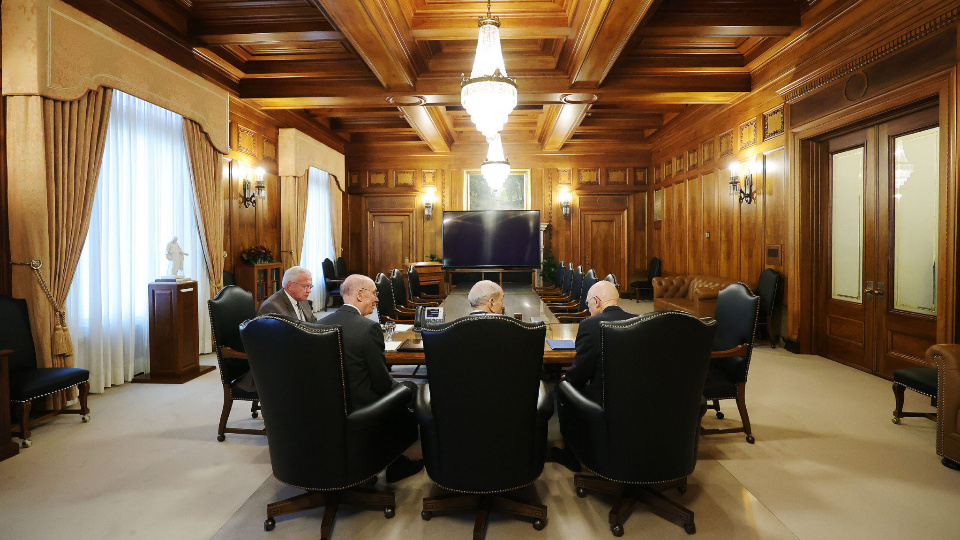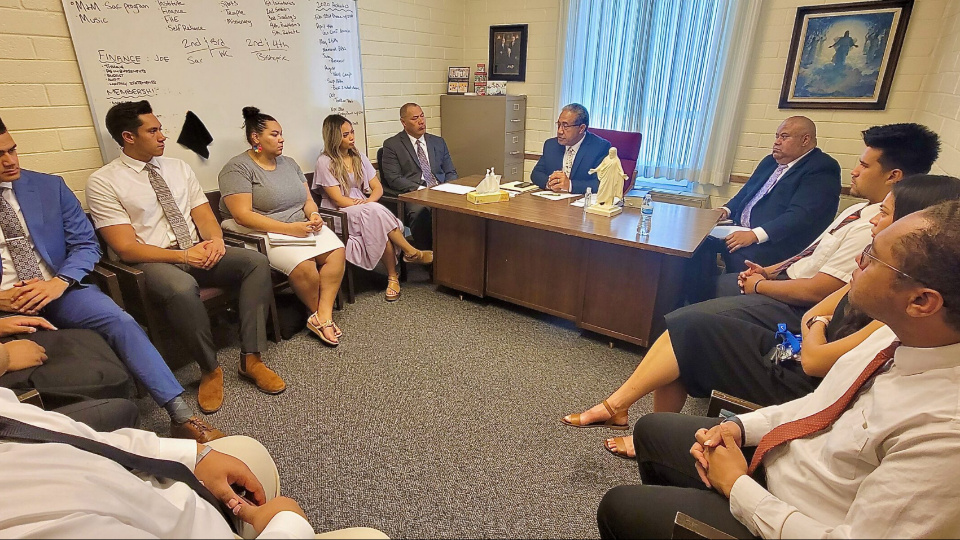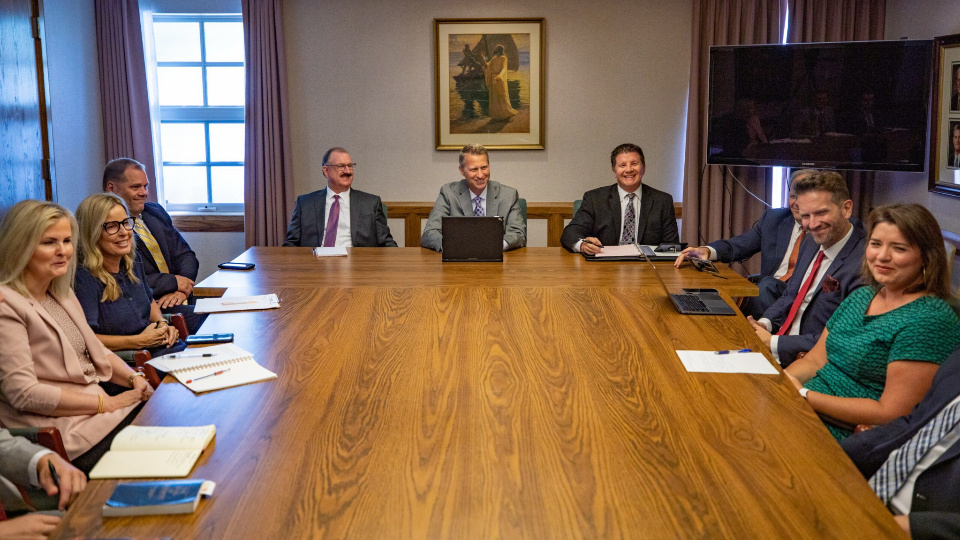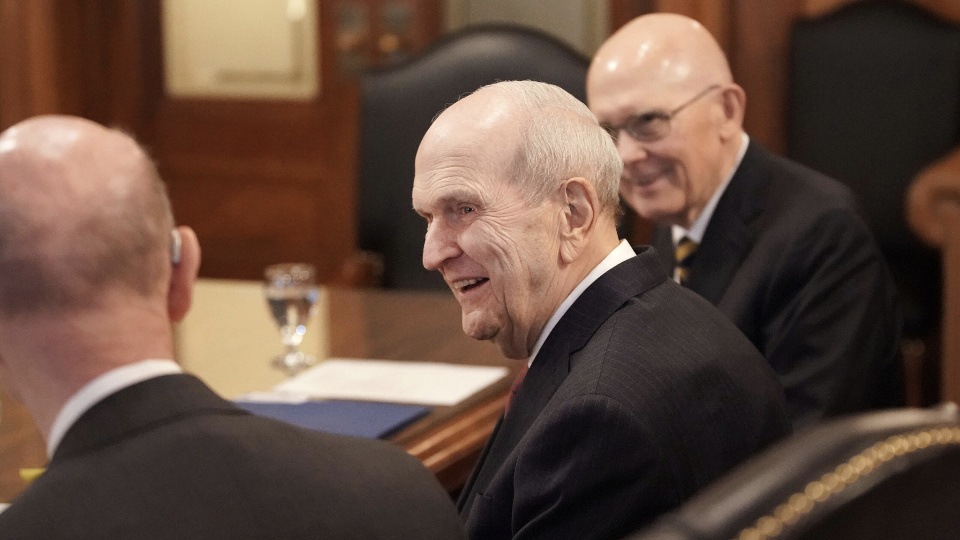| President Russell M. Nelson of The Church of Jesus Christ of Latter-day Saints and his counselors in the First Presidency, President Dallin H. Oaks, first counselor, and President Henry B. Eyring, second counselor, attend their weekly First Presidency meeting at the Church Administration Building in Salt Lake City on Wednesday, June 16, 2021. Photo by Jeffrey D. Allred, courtesy of Church News. Copyright 2021 Deseret News Publishing Company. | 1 / 10 |
This story appears here courtesy of TheChurchNews.com. It is not for use by other media.
By Sydney Walker, Church News
Editor’s note: This is part one in a four-part series on the essential role of councils in the Church, beginning with the Council of the First Presidency and Quorum of the Twelve Apostles and extending to stake, ward and family councils. Learn more in part 2, part 3, and part 4.
When asked what he has learned about the importance of councils in The Church of Jesus Christ of Latter-day Saints, President Dallin H. Oaks, first counselor in the First Presidency, thinks back to an experience he had in his late 20s.
President Oaks was a newly called second counselor of a stake presidency in Chicago, Illinois, at the time. In one of the first meetings he attended, the stake president indicated a stake center needed to be built to accommodate the large number of units in the stake.
The stake president suggested the stake center could be located in the western suburb of Naperville and asked what his counselors thought. “The first counselor said he thought that was a good idea,” President Oaks recalled. “And I said, ‘I think that’s a bad idea.’”
After a few minutes of discussion in which President Oaks outlined his concerns with the location, the stake president invited his counselors to pray about the decision and plan to talk about it at their next meeting.
“The instant I put it before the Lord,” President Oaks said, “I got as strong an impression as I’ve ever had: You’re wrong. Get out of the way.”
At the next meeting, he was on board with building the stake center in Naperville.
“The purpose of the council was to introduce a subject and to stimulate me to prayer, and with the benefit of revelation, I came in line,” President Oaks said. “We had what the Lord wanted — unity — and a stake center was built. And yes, you’ll find it in the western suburbs of Chicago. It’s not where I thought it ought to be, but it’s where the Lord wanted it.”
Seated shoulder to shoulder in President Henry B. Eyring’s office in the Church Administration Building, President Oaks and President Eyring, second counselor in the First Presidency, recently spoke to the Church News about the essential role of councils in the Church and the revelatory process that comes through counseling in the Lord’s way.

Councils-part-1
President Russell M. Nelson of The Church of Jesus Christ of Latter-day Saints and his counselors in the First Presidency, President Dallin H. Oaks, first counselor, and President Henry B. Eyring, second counselor, attend their weekly First Presidency meeting at the Church Administration Building in Salt Lake City on Wednesday, June 16, 2021. Photo by Jeffrey D. Allred, courtesy of Church News. Copyright 2021Deseret News Publishing Company.Inviting a Revelatory Process
As he reflected on his experience in Chicago, President Oaks said he remains grateful the stake president invited input instead of forcing a decision.
Had the stake president said something like: “The Lord told me it should be in Naperville. Will you sustain me?” President Oaks said: “I would have sustained him. But the process wasn’t complete.”
President Eyring remembers observing a similar principle the first time he attended a meeting with the Quorum of the Twelve Apostles. Not yet an Apostle at the time, President Eyring was a guest at the meeting.
As he watched the Brethren discuss an item, “I thought they had reached, after a lot of differences of opinion, a consensus,” he recalled. “And the President of the Church who was in the chair said: ‘I sense there is someone in the room who is not settled yet. We’ll bring it back another time.’”
President Eyring said as they filed out of the room, he noticed a member of the Quorum of the Twelve Apostles tell the President of the Church, “Thank you.”
Whether in a meeting with the Quorum of the Twelve Apostles, a stake presidency meeting or even a family council, “the great leader of a council is very sensitive to that — not to try to force unanimity or consensus but wait until it actually happens,” President Eyring said.

Councils-part-1
Bishop Paula F. Ika leads a ward council discussion in the Provo YSA 221st Ward Tongan on Sunday, June 13, 2021, in an Orem, Utah, meetinghouse. Photo by Scott Taylor, courtesy of Church News.Copyright 2021 Deseret News Publishing Company.Counseling in the First Presidency
Even with decades of Church service, President Oaks and President Eyring — whom President Russell M. Nelson called to serve as his counselors when he was sustained as President of the Church in January 2018 — continue to learn principles of decision-making from President Nelson’s leadership.
“I sat beside President Nelson for about 34 years before he was called as President of the Church, and I was called into the First Presidency,” President Oaks said. “In the Quorum of the Twelve, President Nelson was a member of the Council of the Twelve Apostles. He was not the decision-maker.
“What I have learned serving with President Nelson is that he is a different man when the mantle of the Lord settles upon him, and he becomes the Lord’s Prophet, the President of the restored Church, and the ultimate decision-maker in the Church. I see him making decisions and giving counsel in a far different way than I saw in 34 years of sitting beside him in the Quorum of the Twelve.”
President Eyring has served in three different First Presidencies. Prior to serving with President Nelson, he was second counselor to President Gordon B. Hinckley and first counselor to President Thomas S. Monson.
“Each did it a very different way,” President Eyring said of how the presidents of the Church organized the First Presidency. “But what they had in common was a feeling of tremendous regard for their counselors and seeking their views.”
President Eyring said if they were meeting together and he wasn’t forthcoming with an opinion, they each might say: “Hal, you’ve got something on your mind. What is it? Speak up.”
In every case, the members of the First Presidency have brought unique insights and perspectives to items discussed.
“Every time an issue comes before the First Presidency, it’s fun to see he and I come at it slightly differently,” President Eyring said of President Oaks. “I know he has been a judge, and a great lawyer, and he’ll see some things that I can’t see. …
“He will often say after meeting, ‘Well, we came at it differently, and we came out together at the end.’ … It may not be the view that he or I had to begin with. It may be a joint thing that we’ve seen together.”
Of counseling with President Eyring, President Oaks said: “He sees problems and relevant facts that I didn’t even know existed. And then I apply my judgment and background, and when we get through, we listen to the Lord’s will through the one who presides in the council.”
The Strength of Councils
President Oaks said that as a person participating in a council has the opportunity to speak what is on his or her mind — “and if the other people are listening, with the thought that he might have something from the Lord that I don’t have yet,” President Eyring added — “then the process ends in unity, and unity comes from the Lord.

Councils-part-1
Bishop Chris Johnson, middle, and other members of the Santa Margarita Ward council of the Rancho Santa Margarita California Stake voice their thoughts about a discussion item on Sunday, June 27, 2021. Photo courtesy of Alan Gibby, courtesy of Church News.All rights reserved.More About the Four-part ‘Inside Church Headquarters’ Series
Part one — President Dallin H. Oaks and President Henry B. Eyring discuss what they have learned about revelation in councils and from President Russell M. Nelson’s leadership.
Part two — President M. Russell Ballard and other members of the Quorum of the Twelve Apostles explain why the Church is governed by councils and give examples about how “inviting, receiving and recognizing revelation” can happen in every council.
Part three — Members of the Quorum of the Twelve Apostles and general women leaders give insight into the purpose and functions of three of the Church’s executive councils: the Missionary Executive Council, the Temple and Family History Executive Council and the Priesthood and Family Executive Council.
Part four — Church leaders highlight principles of counseling practiced at the general level that can help stake, ward and family councils be more effective.
Copyright 2021 Deseret News Publishing Company












